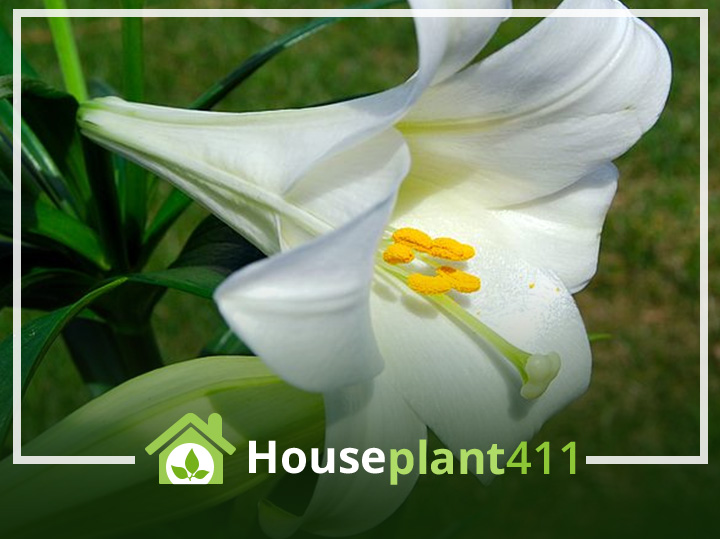The Easter Lily plant or Lilium longiflorum is a plant native to the Ryukyu Islands of Japan and Taiwan and before the start of the Second World War all of our bulbs came from there. After 1941 commercial production of Easter Lily bulbs shifted to the United States. Ten farms situated along the California/Oregon coast today produce almost all the Easter Lily bulbs. The bulbs are picked in the fall and then shipped to greenhouses around the country. The commercial greenhouses plant them in pots and force them to bloom in time for Easter. The Easter Lily Plant is the fourth most popular potted flowering plant, behind the poinsettia, mum, and azalea. This is amazing when you realize that poinsettias are sold for around six weeks, mums & azaleas all year, and Easter Lily plants for only two weeks. Easter Lily plants produce a number of trumpet shaped, white, fragrant, outward facing flowers that are said to represent “purity, virtue, innocence, hope, and life. According to legend, Lilies grew where Jesus’ sweat fell to the ground during his final hours on the Cross. Churches are filled with Easter Lily Plants during Easter to commemorate the resurrection of Jesus. When buying an Easter Lily select a medium sized compact plant that has numerous dark green leaves down to the soil line and flowers in different stages of opening. There should be just one or two partially open blooms, and three or four plump unopened buds. That way you’ll have flowers opening and lasting for several days. These plants are considered poisonous and should be kept away from pets and children. Read more about common houseplants that are poisonous in my book Don’t Feed Me to Your Cat: A Guide to Poisonous Houseplants.
Plant Care
Light
Easter Lily Plants need bright indirect light but no direct sun.
Water
Water an Easter Lily Plant when the first inch or two of soil is dry. Be careful not to over water or to allow the Easter Lily Plant to sit in water. Many Easter Lily Plants come in a decorative wrap. Remove this wrap when watering so excess water can drain freely from the Easter Lily plant and allow the plant to air out before replacing the wrap. When buying an Easter Lily Plant, avoid plants that have soggy soil, since may indicate root rot.
Fertilizer
It’s not necessary to fertilize an Easter Lily Plant while it is in bloom. However, once all of the blooms are gone, and you’ve placed the Easter Lily Plant in a sunny spot indoors or planted it outdoors, fertilize about every six weeks with a slow release plant food.
Temperature
Easter Lilies prefer moderate to cool temperatures, 60-75 during the day and 55-65 at night. Like many other flowering plants, they do not do well in drafts or placed near fireplaces, heating vents, or appliances that give off heat.
Flowering
As the fragrant flowers of an Easter Lily Plant develop, cut off the yellow anthers at the center of the flower. This helps the lilies last longer and prevents the pollen from ruining the lovely white blooms. Easter Lily will not re-bloom indoors.
Soil
If you decide to plant your Easter Lily outside after they finish blooming and all danger of frost has passed, use a quick draining rich organic soil.
Pot Size
An Easter Lily plant never needs to be repotted.
Pruning
Immediately cut off the fading flowers to keep an Easter Lily plant looking good and growing.
Propagation
Easter Lily Plants are propagated by bulb division.
Special Occasion
The go-to plants to give at Easter.
Poisonous Plant Info
All Lily Plants are poisonous, especially for cats. Cats become ill if they ingest any part of an Easter Lily.
FAQ
Cut an Easter Lily Plant back to the soil level once the leaves have turned yellow. Cover the lily Plant Bulbs with mulch to protect them during the winter. In the spring, when the danger of frost has passed, remove the mulch so the new Easter Lily plant sprouts can grow.
You should plant Easter Lily Plant Bulbs about 6″ (15cm) deep and about a foot (30cm) apart. The soil for an Easter Lily Plant should be rich in organic material and be loose enough to drain easily.
Easter Lily Plant Bulbs don’t go dormant so you should never store them. Once the flowers of an Eater Lily Plant die, put your Easter Lily Plant in a bright location until all danger of frost has passed, then plant it outside.

